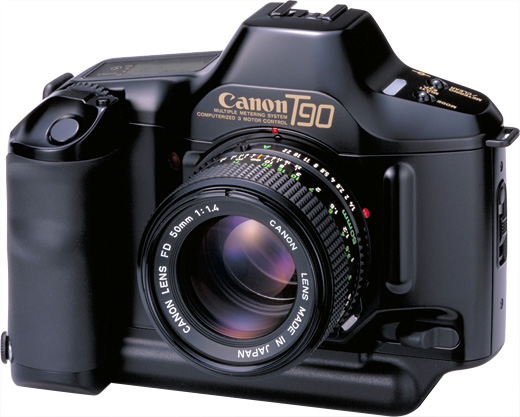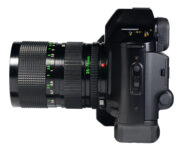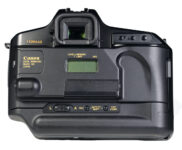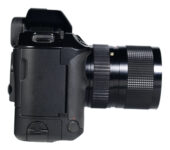Canon T90
35mm MF film SLR camera • Discontinued
- Announced:
- · February 1986
- Production status:
- ● Discontinued
- Country of design:
- · Japan
- System:
- · Canon FD (1971)
Specification
| Format: | |
| 35mm full frame | |
Film type: | 135 cartridge-loaded film |
| Canon FD [42mm] | |
| Shutter: | |
Type: | Focal-plane |
Model: | Electronically controlled |
Speeds: | 30 - 1/4000 + B |
| Exposure: | |
Exposure metering: | Through-the-lens (TTL), open-aperture |
Exposure modes: | Programmed Auto |
| Aperture-priority Auto | |
| Shutter-priority Auto | |
| Manual | |
| Physical characteristics: | |
Weight: | 800g |
Dimensions: | 153.1x121x69.4mm |
Manufacturer description #1
Developed as the top-of-the-line T-series camera, the T90 is a multi-mode SLR with built-in motor drive. The form of the pentaprism hump is a distinct characteristic. Instead of being sharp-edged like on previous cameras, it is rounded with smooth curves. The camera was designed to lessen the picture-taking burden on the user via automation. It aimed for seamless operation to respond to the user’s will. A lot of top-notch technology and thought went into the camera.
The camera has three metering systems to suit diverse shooting conditions. Eight autoexposure modes and two manual exposure modes also make the camera highly versatile. Drive operations are divided among three small coreless motors to consume less power. With four size-AA batteries, the built-in motor drive can shoot at a maximum of 4.5 fps. It was truly a top-of-the-line camera. In Japan, the camera’s nickname was “Tank.”
Manufacturer description #2
EXPERIENCE A RARE MASTERPIECE OF CAMERA DESIGN
Canon now invites you to experience the most striking new direction in SLR body design in many years.
Take a few minutes to give the T90 a careful looking over. Notice the clean surfaces and sleek, sensual lines, the uncluttered layout, the superb balance and proportion. The tool of the creative photographer has itself become a work of art.
Hold the T90, and discover instantly how sophisticated outward appearance reflects its inner quality. The T90 rests in the hands naturally, comfortably - like no other camera. It has the unmistakable feel of solid quality. Its controls are unobtrusive, but absolutely accessible.
Experience complete unity of form and function in a rare masterpiece of design: the Canon T90.
ADVANCED CAPABILITIES TO SERVE THE NEEDS OF THE SERIOUS PHOTOGRAPHER
The T90 was designed entirely from the photographer's point of view. So it is perhaps sensible to talk not about what the camera does, but rather about what the photographer can do with the camera.
The photographer can do so much with the T90: Shoot at shutter speeds up to a lightning-fast 1/4000 sec. or flash sync up to 1/250 sec. Determine light values with one of three different metering systems, including sophisticated multi-spot metering. Decide exposure according to an incredible variety of AE modes, including seven different program modes and an array of exposure compensation features.
The T90 collects and processes and enormous amount of information, yet it does so without clutter and confusion. There is nothing to come between the photographer and the image he seeks.
MAXIMUM 4.5 FRAMES-PER-SECOND SHOOTING WITH BUILT-IN MOTOR DRIVE
A high-speed motor drive is more a necessity than a luxury for sports photography or just keeping track of the action. That's why a two-speed film transport is designed as an integral part of the compact T90 body - and why it is designed to operate on just four size-AA batteries. There's no bulky additional motor drive to get in the way when speed and agility are essential.
1/4000 SECOND SHUTTER SPEED
The T90's ultra-fast shutter allows the photographer mastery over subjects far too fast for the eye to catch. The briefest instant is frozen in time. The 1/4000 sec. shutter speed, combined with the built-in motor drive, makes the T90 an incomparable tool for action photography.
CENTER-WEIGHTED AVERAGE METERING
Average metering means simply that light values over the whole picture area - with some emphasis on the center - are averaged for an overall reading. If light is evenly distributed over the picture, or if there is an overall balance of light and dark areas, as in this photograph, this metering mode is easiest to use and yields best results.
PARTIAL METERING
Partial metering measures mainly the center area of the picture, about 13 % of the total, for excellent results when a subject is surrounded by an especially light or dark background.
SPOT METERING
The spot metering pattern measures only about 2.7% of the picture area, allowing the photographer extremely precise exposure control.
MULTI-SPOT METERING
The T90 offers multi-spot metering for those pictures which demand a delicate balance among several picture elements. The photographer takes spot meter readings of up to eight points, which are averaged by the camera to determine a final exposure setting. An easy-to-read viewfinder display shows each reading.
HIGHLIGHT CONTROL
All cameras tend to reproduce predominantly white scenes with a dull gray cast. The T90's variable Highlight control uses spot metering to let the camera see whites as they really are. And unlike other H/S controls, the T90 system allows the photographer to compensate for different levels of brightness by adjusting Highlight compensation up to 4EV in half steps.
SHADOW CONTROL
The Shadow control works like the Highlight control to keep blacks dark - the way they appear to the human eye. And, like the Highlight control, compensation can be adjusted according to how dark the subject is. Again, variable compensation has been used for two versions of the subject, both with attractive, deep, dark tones. Which is the "better" image is simply a matter of personal preference.
SHUTTER-PRIORITY AE
In the Shutter-priority AE mode, the photographer sets the shutter speed at any point between 1/4000 and 30 sec., including half-step settings, for an unprecedented 36 shutter-speed settings in all. The camera sets the aperture automatically. This extraordinarily fine degree of control has long been in demand by sports photographers and other professionals. The T90's Safety Shift can be switched on to automatically to override the set shutter speed to avoid over- or underexposure.
APERTURE-PRIORITY AE
The T90's Aperture-priority AE mode provides the photographer with easy and complete control over depth-of-field. The aperture is set using the T90's exclusive Electronic Input Dial and clearly displayed both on the LCD Display Panel and in the viewfinder - there is no need to adjust the aperture ring on the lens. Shutter speed is set automatically. With Safety Shift switched on, aperture is automatically adjusted to prevent over- or underexposure.
PROGRAM AE
The T90's Program AE mode allows the photographer to react swiftly enough to capture momentary images before they disappear forever. The camera makes all exposure adjustments according to a standard program suitable for general photography where there are no special exposure problems.
VARIABLE-SHIFT PROGRAM AE
For the photographer who demands both a high level of creative control and the speed of Program AE shooting, the T90 offers Variable-Shift Program AE. The photographer chooses from among seven exposure programs: three small-aperture-priority "Wide" programs, Standard Program and three high- shutter-speed-priority "Tele" programs.
The "Wide" programs can be used to blur fast action or maintain maximum depth-of-field, and are most often appropriate for use with wide-angle lenses.
"Tele" programs freeze the subject in time and isolate the subject against the background. They are especially suited for use with telephoto lenses.
MULTIPLE EXPOSURE
Shooting multiple exposures with the T90 requires no complicated manipulation of film transport mechanisms and does not confuse the camera's frame counter. Simply use the Electronic Input Dial to set the T90 to shoot from two to nine exposures on a single frame. The number of multi-exposures left to shoot is displayed on the camera's LCD Display Panel.
STOPPED-DOWN AE
The T90 has a Stopped-down AE mode for use with close-up accessories such as bellows or extension tubes. Automatic stopped-down shooting can be done while visually confirming the depth-of-field. In this mode, lens aperture is set manually using the lens aperture ring.
MANUAL OVERRIDE
For situations that call for full creative control of exposure by the photographer, simply set the T90 to the Shutter-priority AE mode and move the lens off of the "A" mark. Shutter speed is set on the camera and aperture is set using the lens aperture ring, referring to the metered aperture value displayed in the viewfinder.
THE ULTIMATE IN FLASH SOPHISTICATION
When used with the 300TL dedicated flash unit, the T90 is capable of taking flash photos impossible with any other camera. New features like A-TTL (Advanced TTL). FE Lock (Flash Exposure Lock), and second-curtain sync combine with the T90's 1/250 sec. flash sync speed to make a great variety of complex flash effects as simple as ordinary available-light photography.
MAXIMUM 1/250 SEC. SYNC SPEED WITH A-TTL
High-speed flash sync speed opens up a new world of faster flash photography. With the flash unit attached, the T90's shutter speed can be set manually or automatically anywhere between 1/250 and 30 sec., giving the photographer great control over subject movement, depth-of-field and ambient light. Canon's new A-TTL system balances exposure of the background and subject for superb flash results in daylight and at night. In this fill-in flash situation, the T90 reduced the flash emission level automatically to prevent unnatural lighting of the subject, while accurately exposing the background.
CANON'S EXCLUSIVE FE LOCK
The 300TL's FE Lock mode employs spot metering and the principle of AE lock to provide accurate flash exposure of the subject in any situation.
FE LOCK AND H/S CONTROLS FOR IDEAL BALANCE OF SUBJECT AND BACKGROUND
The Speedlite 300TL's FE Lock mode can be used with the T90's Highlight/Shadow controls for independent control of exposure for subject and background. Once the subject is metered and locked in with FE Lock, the viewfinder display shows how bright or dark the background is in relation to the correctly exposed subject. The H/S controls can then be used to bring the background into balance with the subject.
FE LOCK AND H/S CONTROLS FOR INDEPENDENT EXPOSURE OF SUBJECT AND BACKGROUND
The H/S controls can also be used to vary the background according to the photographer's intentions.
FIRST-CURTAIN SYNC
With the T90 and Speedlite 300TL, it is also possible to make long flash exposures with traditional first curtain sync.
SECOND-CURTAIN SYNC
Until now, flash synchronization has always been timed for when the first shutter curtain is fully open. Now, the T90 and Speedlite 300TL offer the alternative of flash output just before the second shutter curtain begins running.
A TIMELESS LENS SYSTEM FOR THE CAMERA OF THE FUTURE
The Canon FD lens system is an ideal complement to the T90 camera system. Both offer outstanding quality, easy handling, and extraordinary creative flexibility. Choose from Canon's complete line of wide-angle, fish-eye, telephoto, super-telephoto, macro, zoom and standard lenses. There is a Canon lens for virtually any photographic application.
NEW TECHNOLOGIES THAT EXTEND YOUR PHOTOGRAPHIC REACH
Canon's goal in creating the T90 was to put at the photographer's disposal the widest possible range of photographic tools. To do this, Canon had to stretch the limits of the technically possible, searching out new solutions to some of photography's most basic functions.
The search for innovation took many directions and yielded far-reaching results. Canon took a new look at the way data is input by the photographer and improved information readout. And much more: Canon developed its own high-speed electronic shutter. Revolutionized automatic film transport. Set new standards of sophistication in micro-circuitry. Found startling ways to use less power to do more work.
The T90 is an unprecedented technological achievement. And with the T90, every contribution to the science of camera engineering is also a contribution to the art of photography.
EXTRAORDINARY INNOVATIONS AT THE CRUCIAL INTERFACE BETWEEN CAMERA AND PHOTOGRAPHER
One of Canon's most important design objectives for the T90 was to make the camera's many high-performance functions and technologies instantly accessible to the photographer. This was a fascinating challenge; never before had so many sophisticated features been built into a body so sleek and compact.
Canon met the challenge with an impressive range of innovations in camera control engineering. The most extraordinary new idea is the versatile Electronic Input Dial - the centerpiece of the camera's intelligent control system. In addition, the T90 features a superb display system - both on the T90's display panel and in the viewfinder - that keeps the photographer constantly updated on all relevant camera functions. The result is a camera that is totally responsive to even the slightest demands.
THE T90'S MASTER CONTROL: THE NEW ELECTRONIC INPUT DIAL
The Electronic Input Dial is one of those rare design concepts that transcend existing technical limits. It inputs an incredible volume and variety of information with amazing speed and simplicity. It serves the function of numerous separate controls, thus keeping the layout of the T90 simple and clean.
To achieve this, Canon took the two most common camera control mechanisms - the mechanical dial and electronic pushbuttons - and combined them into an ideal hybrid that offers the advantages of both.
The Electronic Input Dial operates something like a mechanical shutter speed dial. The user can move it quickly from the top of the scale to the bottom in less than a second. But unlike a purely mechanical system, the Electronic Input Dial is not limited by how many settings can be legibly printed on the control.
The technology of the Electronic Input Dial is totally electronic. Since information is input electronically, it can be used for multiple functions with almost any number of settings for each function. But it does not force the user to move slowly, one step at a time, from one setting to another as with electronic pushbuttons.
THE T90 LCD PANEL: INFORMATION AT A GLANCE
The T90's "communications center" is a large, easy-to-read LCD Panel on the top of the camera body. This ingenious information display system solves the problem of clear, straightforward presentation of a large volume of data. The LCD panel displays a total of 226 items for 25 different camera functions. But data is displayed only when it is needed. The LCD panel always remains clutter-free, and the photographer has instant access to any information needed to make a decision.
VIEWFINDER DISPLAY FOR ON-THE-SPOT INFORMATION
The T90's viewfinder displays important information that the photographer needs during the act of photo composition. All information is displayed outside the field of view, in bright LEDs or LCD indicators.
BASIC TECHNOLOGIES THAT OPEN UP A NEW WORLD OF POSSIBILITIES
An impressive range of basic technologies lies behind the extraordinary functions and capabilities of the T90. Behind the incredibly efficient built-in film transport is a completely new drive system using three motors. Behind the ultra-fast shutter speed is a new type of shutter developed by Canon engineers exclusively for the T90. And behind the T90's exposure capabilities are a new system of data handling and a metering system of unprecedented versatility.
CANON CHALLENGES ACCEPTED THINKING ABOUT MOTOR DRIVES
Until Canon developed a solution in the T90, building a high-speed, professional motor drive into a compact SLR body was considered technically impossible. Too-high voltage levels - and therefore too many bulky batteries - were required to drive a high-speed film transport while also powering a high-speed shutter, film rewind and a modern camera's entire range of electronic functions. Motor drives have until now remained an expensive accessory.
Canon's revolutionary Three-Motor System
Like most creative.breakthroughs, Canon's solution to the problems of high-speed film-transport mechanics is elegantly simple. Just use three highly specialized coreless motors instead of a single multi-purpose motor.
The T90 has one motor for automatic forward film transport, a second for charging the shutter, AE mechanism, and quick-return mirror, and a third for automatic rewind. There are several obvious energy-saving advantages to the Three Motor System.
First, each motor can be designed for maximum efficiency in its individual function. For instance, the film can be advanced quickly during auto-loading without activating the mirror.
Then, each motor can be independently controlled, for greater flexibility and a more efficient distribution of the work burden.
Finally, each motor can be placed closer to the mechanism it drives, to improve transmission efficiency. In the case of the forward film-transport motor, Canon was even able to design the world's first two-speed automatic changeover function for motor drive.
Two-speed changeover function
The T90 motor drive features an innovative automatic changeover function that automatically switches speed from the top speed of 4.5fps to 2fps whenever the battery voltage drops below a prescribed level. This saves battery energy and extends battery life, so more pictures can be taken with the same batteries.
Convenient one-second auto loading
The T90's automatic film loading system takes only about two seconds. Simply drop in the film cartridge, extend the leader to the orange mark and close the camera back. The film is automatically advanced up to the first frame at top speed.
Fast auto-rewind
With a coreless motor designed exclusively for film rewind, the T90 offers an exceptionally fast rewind speed-only about eight seconds for a 24-exposure roll. Rewind begins automatically after the last frame is exposed and stops automatically when the film is completely rewound.
CANON'S NEW CONCEPT IN HIGH-SPEED SHUTTERS
The T90's exclusive Permanent Magnet Shutter (PMS) was Canon engineers' original solution to the problem of achieving stable, durable, high-speed shutter operation at relatively low power levels. A few other cameras offer the same top 1/4000-second speed, but only the T90 powers both a high-speed shutter and high-speed motor drive on just four size-AA batteries. And no other shutter matches the T90's for accurate, reliable performance.
The PMS shutter was made possible by an ingenious combination of five important innovations in shutter mechanics.
First, Canon used strong, lightweight, specially coated superduralumin shutter blades - four in front and four in back. They were designed strong enough to withstand the shock of high-speed operation but light enough to move with maximum speed and minimum power.
Second, a high-precision boost spring mechanism, acting like an automobile's turbo-charger, supplies an additional burst of power to the shutter blades exactly when needed.
Third, two quick-return magnets, one for the back shutter blades and one for the front, achieve instantaneous release of the armature. This newly-developed component ensures top speed and accuracy.
Fourth, the T90 shutter achieves a faster response speed by using an exceptionally high-voltage (15 V) drive. Power is boosted by a special DC/DC converter.
Fifth, an exclusive two-step shutter brake combines soft braking and hard braking mechanisms to absorb the powerful inertial force of the shutter blades completely and quickly.
A MAJOR STEP FORWARD IN CAMERA ELECTRONICS
To operate and control the T90's enormous range of functions, Canon has created a completely new microcircuitry system that combines unprecedented computing power with extraordinary energy efficiency.
The backbone of the system is a dual CPU, with a main CPU to handle overall sequence control and the LCD panel, and a sub-CPU to control high-speed data-processing functions needed for exposure calculations, digital displays and motor sequence control. The two CPUs keep in touch by means of a high-speed serial digital I/O interface LSI.
The main CPU, which must be kept operating continuously to respond to various input signals, operates at low power, and handles relatively small amounts of data.
The workhorse is the sub-CPU, which processes massive amounts of data, but operates only when needed-micro-seconds at a time. The sub-CPU alone has a ROM capacity of 6,144 words, a RAM capacity of 192 bytes, and runs 96 levels of sub-routines with command execution times as fast as two micro- seconds.
In addition, the T90 microcircuitry system contains six LSls, four ICs, and a quartz oscillator.
A VERSATILE METERING SYSTEM
As we have seen, the T90 features the world's most versatile built-in metering system, with three metering distribution patterns. Two of these - center-weighted average metering and partial metering - are measured by a double-area sensitivity silicon photo cell placed above the viewfinder eyepiece.
The third metering pattern - spot metering - is measured by another silicon photocell placed in the lower part of the mirror box. During spot metering, light coming through the lens is intercepted by a sub-mirror placed behind the main mirror, functioning as a half-mirror. From here, it is directed to the spot metering cell, where the center portion of the field of view is measured, providing the basis for spot metering exposure calculations. This silicon metering cell is also used for A-TTL and TTL flash metering with the 300TL and ML-2 flash units.
THE T90 SYSTEM: VERSATILE ACCESSORIES FOR THE MOST DEMANDING PHOTOGRAPHERS
The T90 system includes a complete range accessories to extend the photographic reach of the advanced photographer. The two dedicated flash systems in the T90 system - the Speedlite 300TL and Macro Ring Lite ML-2 - combine with the T90's metering and exposure systems to provide automatic flash capabilities never before available in any SLR system.
For computerized information handling, Command Back 90 and Data Memory Back 90 offer a variety of advanced capabilities, including recording of important exposure data.
Wireless Controller LC-2 provides valuable remote control capabilities without the inconvenience of extension cords.
And for a complete range of specialty applications with all types of lenses, the T90 system includes eight interchangeable focusing screens.





